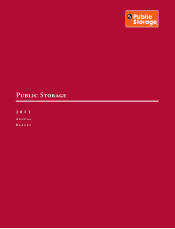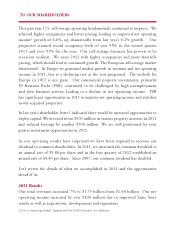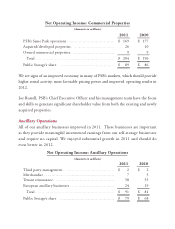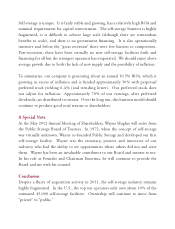Public Storage 2011 Annual Report Download - page 10
Download and view the complete annual report
Please find page 10 of the 2011 Public Storage annual report below. You can navigate through the pages in the report by either clicking on the pages listed below, or by using the keyword search tool below to find specific information within the annual report.past 18 months we have redeemed $2.2 billion of preferred shares. Were it not for the
redemption feature, our $3.3 billion of preferred shares would have a blended rate
of 8.4% versus 6.4%, a savings of about $66 million per year.
Investors in our preferred securities are seeking current income in an investment
they view as “safe.” In an environment where ten year Treasuries yield about 2%,
they view our 5.75% perpetual preferred shares as providing them a “windfall.”
Since we are able to use this capital either to redeem higher coupon preferred shares
or to acquire additional self-storage properties with attractive yields, our relationship
with these investors is truly symbiotic.
Our investment and operating track record is pretty good. Over the last ten years, we
have averaged about a 10.5% annual Return On Assets2 (ROA). This was achieved
while growing significantly (the Shurgard acquisition doubled our assets) and enduring
the adverse effects of the “great recession.” Our annual rental rate growth continues to
outpace inflation (about 1% higher over the last 20 years is our best guess).
Commercial real estate is a very capital intensive business, making ROA critical to
shareholder returns. Changes in ROA over time reflect management’s operational
skills, returns on additional capital investments and the businesses’ sensitivity to the
economy/competition.
Some real estate businesses, such as hotels and suburban offices, have large swings
in ROA since they are extremely sensitive to the economy and require large
amounts of “reinvested capital.” Others, such as industrial buildings, have low
volatility and low ROA since they have longer lease terms, high credit customers
and lower capital reinvestment requirements. Some, such as apartment buildings,
have lower ROA, but can obtain low cost leverage through Fannie Mae and Freddie
Mac loans. This cheap financing frequently leads to overbuilding and greater
volatility in operating results.
(2) Net operating income (before depreciation) from U.S. self-storage and ancillary operations divided by pre-depreciated book value.
preferred, i.e., perpetual by term but with an option to redeem after five years. In the























